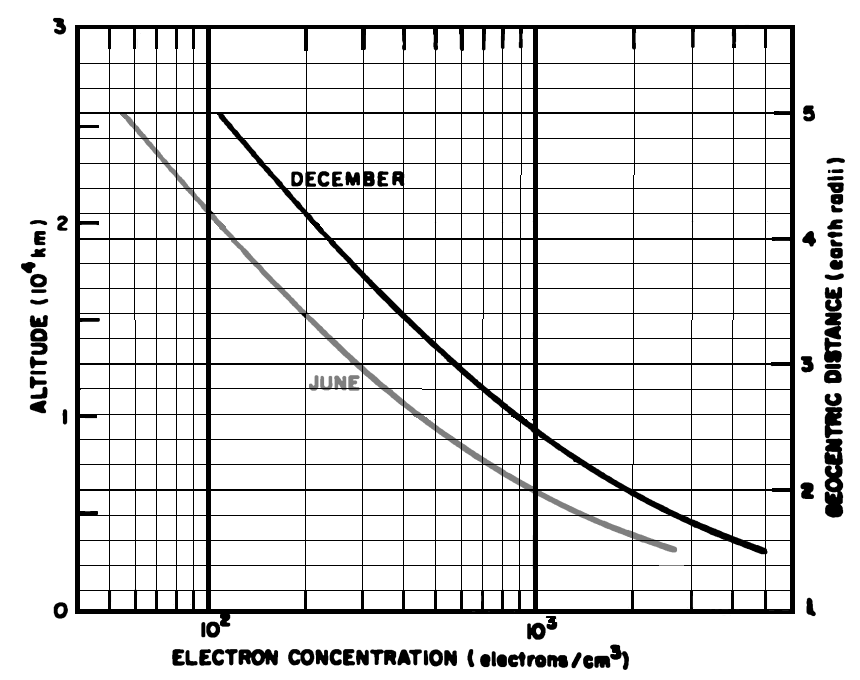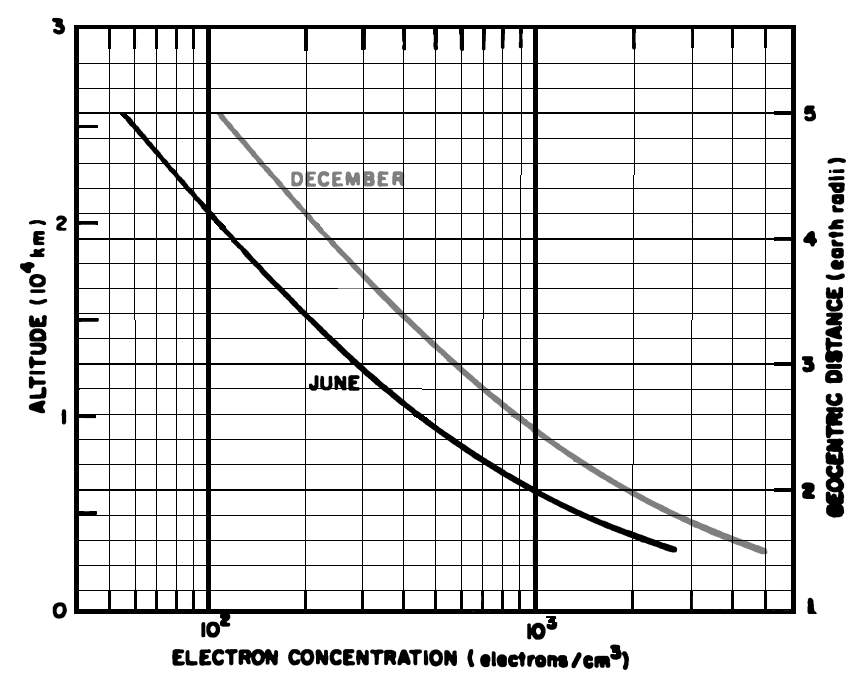Ionosphere and Magnetosphere Density and Charge
The launch loop operates at the bottom fringe of the ionosphere, but launches vehicles into it and through it. Tethers may be used for apogee insertion, and these tethers must contend with drag and lightning/whistler conduction effects in the ionosphere and the magnetosphere. If dynamic structure platforms are not used for a hypothetical space elevator, insulating the tether from the ground, then conduction through the space elevator tether may lead to failures.
Conductivity along field lines ( 0.02 ohm-meter) means a space elevator tether is connected to the lower ionosphere to the north and south. The conductivity perpendicular to the field lines is megaohm-meters. A 1MN, 25MYuri tether will have a lineal density of 40 grams per meter, a cross section of 3E-5 m2 ( at 1330 kg/m3), and a resistance of 0.03 ohms/meter (at 10-6 ohm-meter ). If we think of the elevator tether sitting in a highly elliptical ( 1E6/0.02, or 5E7:1 ) pipe of equal plasma conductivity ( 3E7m2), then the minor axis of the pipe is on the order of 1 meter, while the major axis is 50,000 km, longer than the circumference of the earth. If we think of the space elevator as defining a meter-wide north-south orange-slice of the spherical space around the earth, it is by far the most conductive thing in that slice, and the lowest-resistance vertical electrical path. If current is somehow injected anywhere to the north or south of the space elevator, along the same magnetic longitude, that current will preferentially conduct through the space elevator, perhaps to upper or lower field lines, perhaps to the earth's surface.
So if a lightning storm delivers a few kilocoulombs to the ionosphere above it, magnetically north or south of the space elevator, then that charge will see a meter-wide strip of low conductivity running north-south. That may prove to be the preferential path for that current.
December
L shell |
Equatorial |
Latitude |
Footprint |
Electron |
Debye |
Conductivity |
||
|
Altitude km |
degrees |
km/km |
density |
length |
Para |
Perp |
|
1.0 |
0.0 |
0.0 |
INF |
/m3 |
m |
S/m |
S/m |
|
1.05 |
318.9 |
12.6 |
2.13 |
- |
- |
- |
- |
|
1.1 |
637.8 |
17.5 |
1.44 |
- |
- |
- |
- |
|
1.2 |
1275.6 |
24.1 |
0.93 |
- |
- |
- |
- |
|
1.3 |
1913.4 |
28.7 |
0.70 |
- |
- |
- |
- |
|
1.4 |
2551.2 |
32.3 |
0.56 |
- |
- |
- |
- |
|
1.5 |
3189.0 |
35.3 |
0.47 |
5.0E6 |
1.19 |
- |
- |
|
1.6 |
3826.8 |
37.8 |
0.40 |
4.1E6 |
1.32 |
- |
- |
|
1.8 |
5102.4 |
41.8 |
0.31 |
2.8E6 |
1.59 |
- |
- |
|
2.0 |
6378.0 |
45.0 |
0.27 |
1.9E6 |
1.93 |
- |
- |
|
2.2 |
7653.6 |
47.6 |
0.25 |
1.3E6 |
2.34 |
- |
- |
|
2.4 |
8929.2 |
49.8 |
0.21 |
1.1E6 |
2.54 |
- |
- |
|
2.6 |
10204.8 |
51.7 |
0.18 |
8.8E5 |
2.84 |
- |
- |
|
2.8 |
11480.4 |
53.3 |
0.15 |
7.0E5 |
3.19 |
- |
- |
|
3.0 |
12756.0 |
54.7 |
0.12 |
5.4E5 |
3.63 |
- |
- |
|
3.5 |
15945.0 |
57.7 |
0.09 |
4.0E5 |
4.22 |
- |
- |
|
4.0 |
19134.0 |
60.0 |
0.07 |
2.4E5 |
5.45 |
- |
- |
|
4.5 |
22323.0 |
61.9 |
0.06 |
1.7E5 |
6.48 |
- |
- |
|
5.0 |
25512.0 |
63.4 |
0.05 |
1.1E5 |
8.05 |
- |
- |
|
5.5 |
28701.0 |
64.8 |
0.04 |
- |
- |
- |
- |
|
6.0 |
31890.0 |
65.9 |
0.04 |
- |
- |
- |
- |
|
June
L shell |
Equatorial |
Latitude |
Footprint |
Electron |
Debye |
Conductivity |
||
|
Altitude km |
degrees |
km/km |
density |
length |
Para |
Perp |
|
1.0 |
0.0 |
0.0 |
INF |
/m3 |
m |
S/m |
S/m |
|
1.5 |
3189.0 |
35.3 |
0.47 |
2.8E6 |
1.59 |
- |
- |
|
1.6 |
3826.8 |
37.8 |
0.40 |
2.1E6 |
1.84 |
- |
- |
|
1.8 |
5102.4 |
41.8 |
0.31 |
1.3E6 |
2.34 |
- |
- |
|
2.0 |
6378.0 |
45.0 |
0.27 |
9.5E5 |
2.74 |
- |
- |
|
2.2 |
7653.6 |
47.6 |
0.25 |
6.5E5 |
3.31 |
- |
- |
|
2.4 |
8929.2 |
49.8 |
0.21 |
5.2E5 |
3.70 |
- |
- |
|
2.6 |
10204.8 |
51.7 |
0.18 |
4.2E5 |
4.12 |
- |
- |
|
2.8 |
11480.4 |
53.3 |
0.15 |
3.6E5 |
4.45 |
- |
- |
|
3.0 |
12756.0 |
54.7 |
0.12 |
2.8E5 |
5.05 |
- |
- |
|
3.5 |
15945.0 |
57.7 |
0.09 |
2.0E5 |
5.97 |
- |
- |
|
4.0 |
19134.0 |
60.0 |
0.07 |
1.2E5 |
7.71 |
- |
- |
|
4.5 |
22323.0 |
61.9 |
0.06 |
8.0E4 |
9.44 |
- |
- |
|
5.0 |
25512.0 |
63.4 |
0.05 |
4.7E4 |
12.3 |
- |
- |
|
The Debye length is based on 1250K and electron charge only, and suitable for fast processes. In equilibrium, the ions are at the same temperature contribute, and the lengths are divided by sqrt(2). ???
Electron density estimated from Figure 2-7, a graph on page 34 in the chapter by W.B. Hansen, in The Satellite Environment Handbook, Francis S. Johnson Editor, Stanford University Press 1965. The figure references "The Use of Nose Whistlers in the Study of the Outer Ionosphere" by R.L. Smith, Technical Report No. 6, Contract AF18(603)-126, Stanford Electronics Laboratories, 1960. I need a better tabular or formula source, perhaps below:
Radar and wind velocity
The conductivity is an issue for lightning, but it is also an opportunity to probe high altitude winds with radar. Daytime ultraviolet ionizes the D layer between 60 and 90 km altitude, which can attenuate HF (10 MHz) radio. The E layer from 90 to 150 km altitude remains.
https://en.wikipedia.org/wiki/Ionosphere#D_layer
IRI - International Reference Ionosphere http://modelweb.gsfc.nasa.gov/ionos/iri.html
Ionospheric Conductivity http://wdc.kugi.kyoto-u.ac.jp/ionocond/exp/icexp.html
The Satellite Environment Handbook


